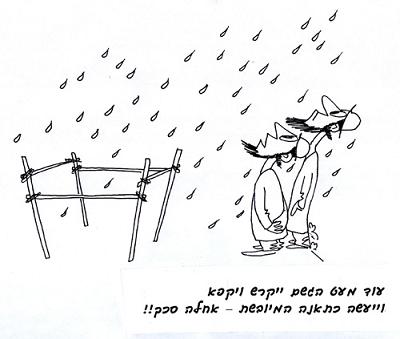
The early sages (the Tanaaim) determined two rules for the thatch on a sukkah: 1. It must be flora; as they put it, “it grew from the ground” 2. It may not be a vessel, like a basket made of fronds, nor food, for example fruit; as they put it “a thing which cannot convey ritual impurity.” The scholars asked: How did the sages know of these conditions? Answer: One sage, Reish Lakish, learned it so, for when the people of Israel left Egypt G-d placed them in booths composed of Clouds of Glory, and clouds are composed of mists which rises from earth, as is written “But a mist went up from the earth and watered the whole face of the ground” (Genesis 2:6). Mists also do not convey ritual impurity, meaning that the thatch must grow from the earth and not be a vessel. The scholars asked: Are there not some sages who think that the people of Israel who left Egypt lived in actual booths and not ones composed of Clouds of Glory? If so, the thatch was not mist.
Another sage learned of it from a different exegesis. It is written in the Torah “You shall observe the Feast of Tabernacles [Sukkot]seven days, when you have gathered from your threshing floor and from your winepress” (Deuteronomy 16:13). The word feat implies the festive sacrifice, meaning an animal. Since the word feast is connected to Sukkot, we can learn that the thatch for the sukkah has the same rules as for animals. Just as the animal grows from the earth and does not convey ritual impurity, so, too, are the conditions for the thatch. The scholars asked: If the conditions for thatch are learned from the animals, then we could conclude that we can thatch a sukkah with animals. Another sage, Rabin, learned the laws of the thatch from the words “you have gathered from your threshing floor and from your winepress,” the straw and the stems of the wheat on your threshing floor and the vine prunings in your winepress, which ground from the earth and do not convey ritual impurity. The scholars asked: Perhaps the intention in mentioning the threshing floor was a single stalk with the wheat attached, and so we could conclude that fruits are permitted as thatch. They continued to ask and say that perhaps the word “winepress” means the grapes themselves and so we could conclude that fruits are permissible as thatch. One of the scholars, R’ Zira, answered that since the word “wine” is used and there is no way to actually use wine as thatch, you are forced to interpret the verse as referring to the vine prunings. Another scholar, R’ Jeremiah, argued that one could actually use wine as thatch if one let the wine clot and harden so it becomes like a dried date; therefore we can interpret the verse as saying we may thatch with wine. Given R’ Jeremiah’s argument, R’ Zira retracted his claim. Another scholar, Rav Ashi, learned of the conditions of thatch from the verse “Go out to the mountain, and bring olive branches, branches of oil trees, myrtle branches, palm branches, and branches of leafy trees, to make booths, as it is written” (Nehemiah 8:15). This implies that the booths were thatched with the branches of various trees. One of the scholars asked: Why did the Scriptures twice refer to the same tree — myrtle branches and branches of leafy trees (according to the sages the leafy tree mentioned is the myrtle)? Answer: One myrtle for the Four Species and a second to thatch the sukkah.
(Babylonian Talmud, Tractate Sukkah 11b-12a)
